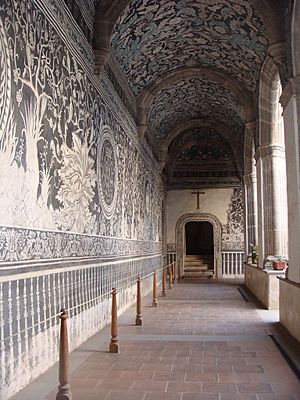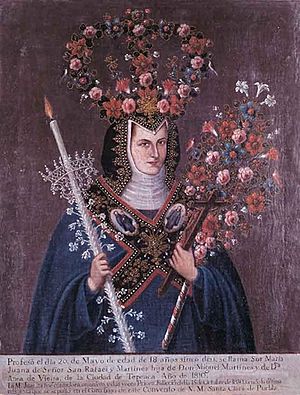Indochristian art facts for kids

Indochristian art (also known as Spanish: arte indocristiano) is a special kind of art from Latin America. It mixes European art styles with the art and traditions of the Indigenous peoples.
When Spain colonized the Americas, groups like the Franciscans, Dominicans, and Augustinians taught Christianity to Indigenous people. They also showed them European art and ideas. So, the art from this time combines European and Indigenous religious beliefs, styles, and traditions.
The name "Indochristian art" was created by Constantino Reyes-Valerio. He was a scholar who studied ancient Mesoamerican cultures and art. He used the term in his book about 16th-century art in Mexico. His ideas helped people understand art across Latin America better.
Contents
What is Indochristian Art?
How the Term Started
The term Indochristian art was first used by Constantino Reyes-Valerio in 1978. He wrote a book about sculptures from the 16th century in Mexico. Later, he also wrote about mural paintings.
Reyes-Valerio defined Indochristian art as art made by Indigenous people but with Christian themes. It blends symbols from both Christian and pre-Hispanic cultures. He studied sculptures and paintings in churches and monasteries in New Spain (which is now Mexico). He found links between these artworks and older Indigenous art.
Reyes-Valerio spent 45 years studying ancient and colonial monuments in Mexico. He looked closely at art details to find Indigenous influences. He also read journals from monks to support his ideas.
He believed that Indigenous artists used their traditional religious images as a way to keep their culture alive. This was a form of quiet resistance.
Why Some People Disagree with the Term
Many experts agree that Reyes-Valerio helped show Indigenous influences in colonial art. However, some art historians have questioned the term "Indochristian." They also questioned his ideas about the cultural setting where the art was made.
For example, Stefanie Wickstrom argues that the term "Indochristian" is too simple. She says it tries to label each part of the art as either "Indian" or "Christian." But she believes the art actually became a new, mixed style. This new style developed as Christian ideas met new cultures.
Other experts have disagreed with Reyes-Valerio's views on colonization. He said that the spiritual conquest (changing beliefs) was more harmful than the armed conquest. He focused on the emotional harm Indigenous people felt when they lost their old religious beliefs.
Recognizing Indigenous Art's Influence
Throughout the 1900s, many people wanted to re-examine the role of Indigenous peoples in Latin American identity. In Mexico, after its revolution, a movement called Indigenismo valued Indigenous culture more. This led art historians to pay more attention to Indigenous art styles. Before this, these influences on colonial art were often ignored.
Over time, more art historians began to see Indigenous influences in Mexican colonial art. In 1939, Agustin Velazquez Chavez said that art in New Spain was a mix of Indian and Spanish cultures. He highlighted the "Mexican" nature of this blend. Miguel Toussaint used the term "mestizo" (mixed) to describe some Mexican art. This showed that Indigenous people were part of creating colonial art.
Another term, "Tequitqui," was created by Jose Moreno Villa. This term, which means "tributary" in Nahuatl, described art that mixed Spanish and Indigenous elements. Moreno Villa compared it to Mudéjar art from Muslims in Spain. Tequitqui was the first term specifically for art combining colonial and Indigenous influences.
Examples of Indochristian Art
The term "Indochristian art" first described Mexican sculptures and murals. But it can apply to any art made by Indigenous artists with Christian themes. This includes many different art styles from colonial Latin America. It becomes harder to use this term for art from later periods. This is because Native and European cultures became more mixed over time.
Religious artworks from colonial Latin America often show Indochristian influences. This art might include:
- Older Indigenous gods or religious symbols.
- Hieroglyphs (picture writing).
- Figures with Indigenous faces or traditional clothing.
- Local plants and animals.
- Traditional Indigenous art styles.
Monastic Art
In the early days of colonization, the church ordered most of the art. Missionaries tried to convert Native people to Christianity. They often tried to get rid of Indigenous culture and make people adopt European ways.
Much of the monastic art from colonial Latin America can be called Indochristian. Murals, paintings, buildings, sculptures, and decorations were often made by Native craftspeople. They included Indigenous symbols in their work.
Cuzco School
The Cuzco School was an art movement in Cusco, Peru. After Spain conquered the Inca empire, Spanish religious artists went to Cusco. They helped convert Inca people to Catholicism. These artists started a school. They taught Quechua and mixed-race people how to draw and paint with oils in European styles.
Cusqueño painters often worked anonymously. They included local plants and animals in their art. They also started painting Inca rulers, which was different from Christian themes. This showed their cultural pride.
Ángel Arcabucero (Arquebusier Angel)
Ángel arcabucero is a type of painting linked to the Cuzco School. These paintings show angels holding an arquebus, which is an early type of gun. The angels wear clothes like those worn by Andean nobles. People believe these angels are connected to ancient winged warriors from pre-Hispanic times.
Monja Coronada (Crowned Nun)
Monja Coronada (Crowned nun) is a type of portrait painting popular in Mexican convents. These paintings honored nuns who wore special bridal clothes and flower crowns. They were common in the 1700s.
From a Christian view, the nuns' bridal clothes symbolize the Virgin Mary. They represent a spiritual marriage to God and victory over sin. But these paintings also mix in Mesoamerican images. They often use a Mesoamerican flower staff instead of a European palm branch. The crowns are decorated with flowers, following traditional flower art. Also, the birds and butterflies in these portraits might represent Indigenous beliefs about the soul and the afterlife.
See also
 In Spanish: Arte indocristiano para niños
In Spanish: Arte indocristiano para niños



